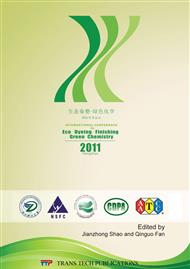p.473
p.478
p.484
p.489
p.494
p.503
p.508
p.512
p.517
Encapsulation of Pigment Using Natural Polysaccharides
Abstract:
With a view to developing UV curable systems from renewable biocompatible raw materials, the present work deals with the encapsulation of pigments with polysaccharide derivatives that can undergo crosslinking upon exposure to UV radiation. Maleate ester derivatives were prepared in anhydrous conditions using maleic anhydride in the presence of pyridine. Encapsulation of the pigment core in the prepared UV curable systems occurred by applying the prepared guar derivative as a shell material in a UV curable formulation that can be induced by a photoinitiator. Encapsulation is done by the o/w/o miniemulsion polymerization technique. In another approach, and for the sake of comparison, microencapsulation was performed via chemical crosslinking of the prepared guar maleate derivative in a W/O emulsion .The resultant nanocapsules were characterized using FTIR, DSC, and SEM. The nanocapsules were spherical with average particle size of 100 nm.
Info:
Periodical:
Pages:
494-502
Citation:
Online since:
January 2012
Authors:
Keywords:
Price:
Сopyright:
© 2012 Trans Tech Publications Ltd. All Rights Reserved
Share:
Citation:


